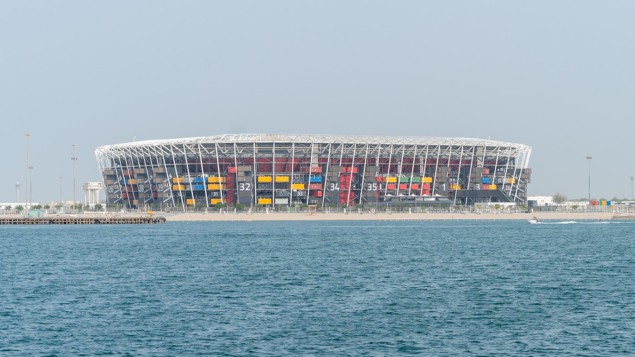
This weekend, the FIFA World Cup kicks off in Qatar, as 32 nations compete in the month-long tournament for national football’s biggest trophy. FIFA, football’s world governing body, estimates over one million spectators will attend the tournament’s 64 matches, with billions more watching on TV. But in the runup to Qatar 2022 concerns have been voiced – some on environmental grounds.
One eye-catching claim has been that Qatar 2022 will be carbon neutral, with organizers pledging to offset the tournament’s 3.63 million tonnes of carbon dioxide equivalent (CO2e). Environmentalists, however, believe the carbon emissions are significantly underestimated and question the transparency of the offsetting process.
Stadiums controversy
Much discussion has centred around the eight tournament stadiums, seven of which were built from scratch after Qatar was awarded the tournament 12 years ago. Given Qatar’s hot and arid climate, pitches there require 10,000 litres of desalinated water daily in winter and 50,000 litres in summer, and grass seeds are flown in regularly from the US on climate-controlled aircraft. Yet, in its carbon accounting for the tournament, FIFA attributes a combined total of just 0.2 Mt of CO2e to stadiums, on the basis they will be extensively used over many decades.
Carbon Market Watch questions whether Qatar – a relatively small country centred around one city – really needed lots of large stadiums, especially given the absence of large sports clubs prior to the World Cup bid. In a report, the not-for-profit organization suggests that the stadia’s real carbon impact could be eight times higher. On the plus side it welcomes the fact that a portion of seats are removeable and that one of the grounds – the so-called “Stadium 947” – is built from shipping containers and modular steel, making it fully demountable.
Going for green
But how can we minimize the environmental impacts of big sporting events more generally?
One recent event to win green plaudits was the 2022 Commonwealth Games in Birmingham, UK, where activities were hosted in revamped non-sporting sites as part of longer-term regeneration plans. It included temporary basketball and volleyball facilities on the Smithfield Market Site in the city centre, and the planting of urban forests across the West Midlands region. Organizers of the Paris 2024 Olympics are said to be following the lead from Birmingham and the Tokyo 2020 Olympics too.

Is the 2022 FIFA World Cup really carbon neutral?
Sport does seem to be waking up to its environmental responsibilities and there are an increasing number of green initiatives at national and local levels. In Germany, many football clubs offer a “KombiTicket” that includes free local and regional public transport to matches. In Spain, Real Betis offers its “Forever Green” platform, including discounts for fans to travel to the match using a local bike-sharing scheme.
Such initiatives are a good idea. A 2017 study across eight of English football’s lower tiers found that nearly seven out of 10 spectators travelled to matches by car. Individuals travelled an average distance of 41.5 km, with the total annual greenhouse gas emission from spectator transport estimated at 56.2 Kt of CO2e per season.
So how is your local sports club cutting its carbon footprint and/or encouraging sustainable behaviours among its fanbase? Let us know on Twitter or e-mail us at pwld@ioppublishing.org



